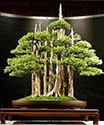|
Going by my local climate, I was thinking of starting out with a Trident Maple, but I have a few follow-up questions. What is the rough cost of a pre-bonsai Maple? If it's elsewhere on this thread, I may have accidentally read past it. And which bonsai bear fruit? Is it consistent by season or does it depend on how you care for the bonsai?
|
|
|
|

|
| # ? Apr 23, 2024 10:41 |
|
Zhaan posted:Going by my local climate, I was thinking of starting out with a Trident Maple, but I have a few follow-up questions. You get what you pay for. It depends on how nice a bonsai you want to wind up with. A relatively cheap seedling might take years of growing in the ground to become a bonsai. If you want to grow bonsai from inexpensive stock, I'd recommend choosing a portion of your yard and just planting 5-10 saplings. I can find a guide for how to trunk chop them if that's what you'd like to do, but be ready to wait 10-15 years. Honestly, this stage of bonsai is monotonous, and I'd recommend buying a better quality tree. Quality bonsai stock is expensive - I would expect to pay at least $150-500 for a trident maple that will become a good tree. Oftentimes excellent stock will be priced higher than mediocre finished bonsai even, and can cost thousands of dollars. Personally, I'd advise you to go to a site called http://www.thegrowinggrounds.com/ The fellow there has been growing trees with his father for quite some time. Most real big names of bonsai have passed through the nursery (Walter Pall, Colin Lewis, John Naka, etc.), and he grows really high quality stock. His trident maples are gorgeous, and you can get something that will become a specimen for around $300 - don't look at the prices on the website, my advice is to roadtrip out to see him if you can and chat him up about bonsai. Chances are he'll knock a couple hundred dollars off the price as compared to the website. Fruit bearing bonsai bear fruit by season, but it's really dependent upon species and how they're kept. One of my ficus came to me bearing fruit, but despite keeping it for 3 more years has never flowered or fruited again. I'm guessing it's something to do with the nutrient ratio of the fertilizer I'm using? I don't know. Edit: A great way to get cheap trees or older, more developed trees is to start going to your local bonsai club. Typically, their auctions are ill attended and have excellent trees. Crocoduck fucked around with this message at 20:46 on Oct 9, 2012 |
|
|
|
I have a cat who is kind of a d-bag and has started chewing on my ficus leaves now that I brought it inside. Will the bitter apple stuff hurt the ficus if I spray it a few times until he stops going after it? I also put aluminum foil around it because cats apparently hate walking on it. If this isn't a good idea does anyone else know how to keep cats away from their bonsai trees?
|
|
|
|
Richard Bong posted:I have a cat who is kind of a d-bag and has started chewing on my ficus leaves now that I brought it inside. Will the bitter apple stuff hurt the ficus if I spray it a few times until he stops going after it? I also put aluminum foil around it because cats apparently hate walking on it. If this isn't a good idea does anyone else know how to keep cats away from their bonsai trees? Euthanasia. Bonsai > Cats.
|
|
|
|
I just put my Ficus up where my cat can't get it. But then again he's never shown any desire to munch on it, so I dunno if that's really very good advice...
|
|
|
|
Crocoduck posted:Euthanasia. Bonsai > Cats. Well the tree definitely shits less so you might be on to something. Mr. Soop posted:I just put my Ficus up where my cat can't get it. But then again he's never shown any desire to munch on it, so I dunno if that's really very good advice... I wish I had a spot he couldn't get to. He didn't want to munch it when I first got it but now that I brought it back in for the winter he is all about it.
|
|
|
|
Richard Bong posted:I have a cat who is kind of a d-bag and has started chewing on my ficus leaves now that I brought it inside.
|
|
|
|
Nothing is out of reach for cats that want to chew on things. My old roommate had two cats, and one of them managed to chew up my pothos vines even though they were in a window 12ft off the ground. Could you perhaps built a moat around your bonsai? Alternately, buying something safe for the cat to chew on might be a good idea. Maybe some pet grass would work, if you can get him to eat that instead.
|
|
|
|
jackpot posted:Not that being poisonous has ever stopped a pet from eating something (when I bring everything in for the winter I have to keep half of my plants in the laundry room because of our cats), but I'm surprised your cat is going for it. Ficus aren't deadly poisonous, but they're not exactly pet-friendly, either. He's kind of just biting through the leaves not really eating it so my outer leaves are just covered in puncture marks and slices, none of the leaves are actually eaten or anything. But I didn't know it was poisonous so you'd think even just biting the leaves would be avoided. He's probably just doing it to spite me because I keep coming home smelling like my girlfriends cat who likes to lay on me while I sleep. Mizufusion posted:Nothing is out of reach for cats that want to chew on things. My old roommate had two cats, and one of them managed to chew up my pothos vines even though they were in a window 12ft off the ground. Could you perhaps built a moat around your bonsai? I'm going to try this next if the bitter apple stuff mixed with water doesn't work. Edit: Enough whining about my cat. What kid of ground covers do you guys use? I just got some sphagnum moss I am trying out, if that doesnt work I am going to try dwarf thyme. Richard Bong fucked around with this message at 20:29 on Oct 12, 2012 |
|
|
|
I just gather whatever moss is growing on the ground and use that. Saw some fancy Japanese mosses at a bonsai show for sale earlier this year. As for indoor bonsai, I don't use anything.
|
|
|
|
Richard Bong posted:What kid of ground covers do you guys use? I just got some sphagnum moss I am trying out, if that doesnt work I am going to try dwarf thyme. I'm going to Ireland in a few weeks; if I wasn't afraid of customs seizing everything (before sending me to Guantanamo) I'd pack bagfulls of moss to bring home with me.
|
|
|
|
jackpot posted:I'm going to Ireland in a few weeks; if I wasn't afraid of customs seizing everything (before sending me to Guantanamo) I'd pack bagfulls of moss to bring home with me. My mom brought some flower seeds & some cuttings from Alaska to Aruba (the second leg of the trip) and back to the states. Pretty sure they smuggled some poo poo from Europe too when we went there years ago. You could always snag a patch a couple square inches wide, keep it moist in a zip lock baggie or bottle or something, and check it with your luggage (hiding it in a spot where a small blemish on x-ray machines doesn't look too suspicious). I also brought LSD from the states to the Bahamas with no problems (taped strips of it to some shorts along the seams, as to blend in when X-Ray'd), but that's considerably smaller than a patch of moss. If anything they just take it out of your bag and leave a note, it's not the worst law in the world to break. Or you could always mail it back to yourself, pay the expense for overnight or 2-day air. Use USPS if possible (doubt it but you never know), not sure internationally but domestically they'd require a warrant to open your mail. FedEx and UPS are private entities so they don't need warrants.
|
|
|
|
After being inspired by this thread, I went to an amazing local bonsai nursery (Bonsai West in Littleton, MA!) and got myself a lovely ficus and a natal plum. When I bought both, the staff told me that the ficus would be easy but the plum would be a little more finicky. Fast forward about 2 weeks and my ficus is still really freaking out -- dropping several yellow leaves a day (it's a decently big bonsai, so it's about 10 leaves a day). The plum? Just dandy. I'm sure the ficus is stressed since it was in a nice greenhouse until I took it away to my tiny Boston apartment, which has only one window (west-facing, floor-to-ceiling deal, can get a few hours of direct sunlight when it finally stops raining around here) but man, *I* am getting stressed looking at my lovely ficus just dropping leaves like it's going out of style. My place is pretty humid normally (I have a humidifier going) and I always have a low fan running as well -- so the air is moving and it's not super-dry. I'm thinking it's just the drastic cut in light, especially since it's autumn? Aside from the yellow leaves, the ficus looks just fine -- it even has new shoots and is fruiting, of all the things. But the pace of yellowing leaves hasn't slowed down, which is starting to worry me. The soil is moist, I have watered it I think 2-3 times in the past 2 weeks (the soil was moist when I got it), so perhaps I am overwatering it? Or no? Any ideas?
|
|
|
|
FloorCheese posted:After being inspired by this thread, I went to an amazing local bonsai nursery (Bonsai West in Littleton, MA!) and got myself a lovely ficus and a natal plum. When I bought both, the staff told me that the ficus would be easy but the plum would be a little more finicky. Honestly, sometimes they just seem like the most temperamental plants. Are you having any dieback of the branches? Are the yellowing leaves near the tips of the branches, or further back in the shrubbery? Do you see any insects associated with the plant? If you're getting fresh growth, I wouldn't be inclined to worry, but my guess is you should be watering more. What sort of soil are you using? Is it pretty organic and potting soil-ish or granular and more like gravel? These are hungry trees in my experience. They love light, they love food and they love water. Post pics! Crocoduck fucked around with this message at 19:03 on Oct 16, 2012 |
|
|
|
FloorCheese posted:After being inspired by this thread, I went to an amazing local bonsai nursery (Bonsai West in Littleton, MA!) and got myself a lovely ficus and a natal plum. When I bought both, the staff told me that the ficus would be easy but the plum would be a little more finicky. This sort of thing will usually happen when a tree from a greenhouse is brought into a house or apartment. Sometimes as much as 60% of the leaves will fall off as the ficus adjusts. The fact that you're getting new growth and fruit on it though is a good sign, as plants will usually not produce new growth and fruit if they're in a dying state. I would suggest to maybe pinch/snip off the fruit in order to redirect nutrients away from producing fruit and back into the leaves of the tree and the tree itself. Also, like Crocoduck said, what kind of soil is it in? That can be all the difference in the world in terms of how often you need to water it.
|
|
|
|
Thank you both for your replies -- the plant isn't showing any stress anywhere else, the new shoots are healthy and continuing to grow. I'll snip off some of the fruits per your suggestion - I was thinking that might be something to try - since I think I have something like 15 baby figs (at least!) on this guy. All the leaves yellowing and falling off are definitely older ones in the back where there's less sun. I'm not too familiar with ficus yet, I was thinking this might just be the plant shedding leaves that aren't getting enough sun, but I don't want to make poor assumptions here  Definitely no bugs that I can see. I have been checking the dropped leaves for any scale, nothing yet. Nothing on the soil either. I think I am so far pest-free. This is definitely slightly-more gravely soil, not standard potting mix by any stretch. It's not as gravely as succulent mixes (like the stuff I've used for cacti). I believe it's the greenhouse's proprietary bonsai soil mix of some kind: http://www.bonsaiwest.com/index.php/bonsaiwest/item/251 I do check it morning and night for moisture since it's still a new plant and I'm trying to get to know it better. We haven't had very much sun at all lately -- I think 1 hour of direct sun MAX a day the past few days -- so I am trying to make sure I am not overwatering.
|
|
|
|
FloorCheese posted:Thank you both for your replies -- the plant isn't showing any stress anywhere else, the new shoots are healthy and continuing to grow. I'll snip off some of the fruits per your suggestion - I was thinking that might be something to try - since I think I have something like 15 baby figs (at least!) on this guy. All the leaves yellowing and falling off are definitely older ones in the back where there's less sun. I'm not too familiar with ficus yet, I was thinking this might just be the plant shedding leaves that aren't getting enough sun, but I don't want to make poor assumptions here I'd definitely water more - I usually give my ficus 20-30 seconds underneath a hose everyday and they're potted in soil very similar to your's. If I were you, I'd consider getting a cheap fluorescent lamp and supplementing the tree's light for ~8-16 hours a day. Like I said, greedy little trees - speaking of which, what are you using as a fertilizer? Oh yo, that website is pretty awesome, I like those bald cypresses he's offering. Crocoduck fucked around with this message at 21:02 on Oct 16, 2012 |
|
|
|
Shouldn't my trident maple and japanese red maple be losing their leaves right about now? The leaves on the trident hasn't even changed colors yet. They are very young (maybe a foot and a half tall each) and I'm growing them out a bit, but it's fall and I thought they'd lose their leaves despite being so young.
|
|
|
|
Crocoduck posted:I'd definitely water more - I usually give my ficus 20-30 seconds underneath a hose everyday and they're potted in soil very similar to your's. If I were you, I'd consider getting a cheap fluorescent lamp and supplementing the tree's light for ~8-16 hours a day. Like I said, greedy little trees - speaking of which, what are you using as a fertilizer? Even if the soil is still really damp? I am concerned I might *over* watering this guy. I did just buy a plant lamp though - that definitely can't hurt. I have a feeling my poor ficus is just going through serious light withdrawal -- it went from probably a few good solid hours of light to, well, maybe one a day if it's lucky. (Normally it'd get more than that where I have it, but we have just had days and days of overcast weather lately.)
|
|
|
|
FloorCheese posted:Even if the soil is still really damp? I am concerned I might *over* watering this guy. Ficus are rainforest plants, it's hard to overwater them. As long as they have proper drainage, they'll appreciate the moisture. Ideally I like to keep my bonsai in completely inorganic soil mix - say turface, haydite or akadama (although akadama can be a bit trickier). I feed them heavily, generally half dilution miracle gro every day of the growing season, or organic fertilizer applied every couple of weeks (outdoor ONLY). Because salts from fertilizer can build up in the soil, I also water heavily, partially to flush these salts out, partially because the fertilizer makes the plants thirsty. Using this method I have gotten 8" of growth on the leading shoot of even small ficus, in like, two or three months. Good website describing it: http://walter-pall-bonsai.blogspot.com/2010/06/feeding-substrate-and-watering-english.html Yo, jerkstore, my trident and japanese maple have lost all their leaves. I wouldn't really worry about it though.
|
|
|
|
If anything, be happy jerkstore!  If they haven't lost their leaves it means they're still growing. Around these parts where I live, the Japanese and Trident Maples don't start turning red until late October to mid-November. It's really dependent on when your cooler temperatures begin to stabilize. If they haven't lost their leaves it means they're still growing. Around these parts where I live, the Japanese and Trident Maples don't start turning red until late October to mid-November. It's really dependent on when your cooler temperatures begin to stabilize.
|
|
|
|
Image dump! For all you ficus growers, one piece of advice of advice I'd give is for everyone to keep whatever cuttings they prune off, stick them in some rooting hormone and just see if they grow.   The second plant is a clone of the first, and now I can use it as a donor for any approach or thread grafts that I might want to make. This sort of trick works very well with trident maple as well, and I'm loathe to cut off any large branch without first trying to air layer it. Speaking of tridents, here's mine in her winter garb. Mr. Soop, I'd be interested in which you liked better as the front for this trident maple:   The strong arm branch near the base is a prime candidate for air layering. I'm also thinking of doing some hollow trunk style carving to correct some of those wounds. Here is the japanese maple - I feel a little more sure of myself with this tree and can't wait to go in with some clippers, but I may wait a month or two.  For some reason the season hasn't diminished the growth of my ficus at all, in fact they're doing quite cool things with their roots.  Reminds me of Akira. Crocoduck fucked around with this message at 21:19 on Oct 17, 2012 |
|
|
|
Something I've been wondering as I'm seeing acorns falling to the ground everywhere -- why aren't oak trees popular bonsai specimens? Do their leaves tend to be too big, or do they not tolerate the pruning and root trimming well?
|
|
|
|
nobody- posted:Something I've been wondering as I'm seeing acorns falling to the ground everywhere -- why aren't oak trees popular bonsai specimens? Do their leaves tend to be too big, or do they not tolerate the pruning and root trimming well? I think its because they take a billion years to grow. Im going to be attempting to grow some Australian Natives into bonsai soon, after seeing these  River Red Gum (Eucalyptus camaldulensis)  Narrow leaf Peppermint (Eucalyptus nicholli)  Bottlebrush (Callistemon viminalis) The biggest issue with playing with Aussie natives is that they HATE their roots being touched and can quite often just turn up their feet and die after a re-pot!
|
|
|
|
Ferremit posted:I think its because they take a billion years to grow. I read a book a while back on Australian species for bonsai, I copied down some of the advice it gave into a word document, here is is: Bonsai with Australian Plants posted:Australian bonsai This is a cool thread, I have a few trees in progress but nothing really worth showing at the moment. If you want to get more into bonsai it's worth looking for a bonsai club or society in your area. Talking to people in person often makes it easier to understand than reading articles on the internet or in books. Fair warning that most clubs are predominately older people though.
|
|
|
|
Fruit trees seem popular around here so I thought I'd share these. They aren't mine, just saw them on the net.  
|
|
|
|
I've only found this thread today and I'm loving all the bonsai porn. To me, bonsai trees are just so.. magical, if you know what I mean? I can't explain it, it's the same sort of thing with nice aquascaped aquariums, like some beautiful miniature world. Anyhow about 2 weeks ago I was thrilled to find a wee oak seedling in a flowerbed, maybe a gift from the birds or squirrels, and I would love to dig it up and bonsai it. Should I leave it to overwinter or get it inside now? The stem is about 3 inches tall and it has 3 leaves, last time I looked. I've been meaning to start bonsai for years and have that many books on the subject but I just never got to it. I'm quite successful with plants and grow everything from seed and cuttings so I shouldn't find it a problem, but I think about how many years it would take to look how I want and then I start feeling old and sad!
|
|
|
|
pants cat posted:I've only found this thread today and I'm loving all the bonsai porn. To me, bonsai trees are just so.. magical, if you know what I mean? I can't explain it, it's the same sort of thing with nice aquascaped aquariums, like some beautiful miniature world. You should check out Takashi Amano's stuff if you like fish tanks - he very much uses a similar aesthetic. As for your oak tree, you've got a lot of time and a lot of choices to make. Because it's so young, you can pretty much determine exactly how you want to develop the trunk, the style, etc. Unfortunately it will take between a long time and a very long time to get the tree in shape, so be patient and try to forget about the little tree for a while. Here's a good guide to field growing trees: http://www.bonsai4me.com/AdvTech/ATfieldgrowing.htm You might think about relocating it to someplace in the yard where it will be easy to remove in five years, or maybe less if you'd like to train a shohin or mame sized tree.
|
|
|
|
Cheers Crocoduck  I guess the baby oak can stay where it is for a while, it should be safe provided the postman doesn't walk across the flowerbed, he's got previous form for that. I guess the baby oak can stay where it is for a while, it should be safe provided the postman doesn't walk across the flowerbed, he's got previous form for that.Yeah Amano's tanks are awesome, I don't have much luck with aquascaping as I love my bottom feeders too much and they always mess things up, but I have a big glass bottle I'm going to plant up with no fish this time and hopefully I can make something nice.
|
|
|
|
I got a Chinese Elm bonsai in the mail from ProPlants yesterday (got a Groupon deal on it). I live in Eastern Washington and we get pretty cold here in the winter. Took a peek at the hardiness zones; I'm in zone 6 and Chinese Elms work in zones 5-10, so it should be fine. However, what do I need to do to keep it alive through the winter? Reading on the interwebs shows me I should bury the pot most of the way in the ground and partially cover the base of the tree with some kind of mulch. Is this my best bet? Also, picture!
Thalamas fucked around with this message at 03:03 on Nov 9, 2012 |
|
|
|
If you have proper lights & nutrients can you just keep your tree going indoors without any winter period where the leaves drop (or fruit/flowering if you don't want to)? Or is it necessary to go through the seasonal cycles?
|
|
|
|
It needs the dormant cycle or it gets sick and dies
|
|
|
|
ante posted:It needs the dormant cycle or it gets sick and dies Doesn't that depend on the plant? From what I have read, "indoor" bonsai (like ficus) do not have a dormant cycle.
|
|
|
|
Hey guys, been away for a bit due to broken laptopitis. @Crocoduck: I like the first picture of the Triden Maple more. Even with the large knot/scar being on the front, the tree has more taper. My opinion is that should be your display angle. @FloorCheese & RizieN: Evergreens like Ficus don't have a true dormant cycle in which they loose leaves; they will simply not grow as vigorously or as fast as they would during warmer seasons. Deciduous trees like a Chinese Elm or Japanese Maple should not be brought indoors during the winter, the exception being to put them in a protected area (garage or a shed being good examples) if you are in an area where snow falls. Bringing them inside your house or apartment during the winter will expose them to all sorts of problems, such as warm circulating air that may cause disease and confuse their dormancy cycle.
|
|
|
|
Hey guys, I posted in here a ways back and have since been waiting for my maple seedlings to go dormant so I can transplant them to my new place up the street. Anyhow, interesting story. There's a big cedar-like tree in front of my new house. Today, I suddenly realized that the whole thing has turned orange. I didn't notice it before because it was blending in with the rest of the fall colors. I was all '  oh god the tree is dead!' at first, but then remembered reading about deciduous conifers a while ago, and how this tree looked more like a redwood than a cedar (I'm from Norcal, land of redwoods, but since this is PA, didn't think it could be a redwood). So, turns out it's a Dawn Redwood. Now I want a bonsai Dawn Redwood. oh god the tree is dead!' at first, but then remembered reading about deciduous conifers a while ago, and how this tree looked more like a redwood than a cedar (I'm from Norcal, land of redwoods, but since this is PA, didn't think it could be a redwood). So, turns out it's a Dawn Redwood. Now I want a bonsai Dawn Redwood. Also, been meaning to post this for a while. I saw a really cool ivy bonsai at a show a while back, and thought that would be fun (and relatively easy) to grow some ivy. I came across a really cool variegated ivy cultivar back at my parents' garden:  There were a dozen or so sprouts of this hiding in the garden with the normal ivy. I've never seen this variety in stores or nurseries - it's always the white-rimmed Glacier kind. Googling has told me this is probably the Fantasia cultivar (still not a dead ringer), on which there really isn't much info at all. I like to think I've found a special rare ivy. I'll try to get some cuttings when I'm visiting home for Christmas.
|
|
|
|
Dawn Redwoods can make pretty cool bonsai. The only Catch-22 with them is that they like to be big trees, so a concession you'll have to make is that you'll have a big bonsai of one. They are pretty hardy though otherwise. Ivy can make for some really nice bonsai. Even if it isn't a rare cultivar, it could still make for something good. Grab some cuttings and experiment!
|
|
|
Illudere posted:Fruit trees seem popular around here so I thought I'd share these. They aren't mine, just saw them on the net. Ok these look just totally implausible.
|
|
|
|
|
They're very good examples of the Shohin (bonsai under 9 inches) and Mame (bonsai under 4 inches) bonsai styles. The downside to letting those fruit is that it drains the strength of the tree immensely. As in it probably has at a 50% chance of killing them.  But the people who grew those probably know what they're doing, so I'm sure those ones are fine.
|
|
|
|
I believe they're real (you can see the photographer's reflection in the cherries + look how the apple stems attach), but those apples have got to be getting close to the mass of the whole rest of the tree. I'm not surprised it risks killing them.
|
|
|
|
|

|
| # ? Apr 23, 2024 10:41 |
|
I dug a cold frame for winter maple storage. If you dig below the frost line they shouldn't freeze all winter long. In this photo the plywood cover is not yet attached. 
|
|
|
























